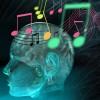BACKGROUND:Melodic Intonation Therapy (MIT) uses the melodic elements of speech to improve language production in severe nonfluent aphasia. A crucial element of MIT is the melodically intoned auditory input: the patient listens to the therapist singing a target utterance. Such input of melodically intoned language facilitates production, whereas auditory input of spoken language does not.
METHODS:Using a sparse sampling fMRI sequence, we examined the differential auditory processing of spoken and melodically intoned language. Nineteen right-handed healthy volunteers performed an auditory lexical decision task in an event related design consisting of spoken and melodically intoned meaningful and meaningless items. The control conditions consisted of neutral utterances, either melodically intoned or spoken.
RESULTS:Irrespective of whether the items were normally spoken or melodically intoned, meaningful items showed greater activation in the supramarginal gyrus and inferior parietal lobule, predominantly in the left hemisphere. Melodically intoned language activated both temporal lobes rather symmetrically, as well as the right frontal lobe cortices, indicating that these regions are engaged in the acoustic complexity of melodically intoned stimuli. Compared to spoken language, melodically intoned language activated sensory motor regions and articulatory language networks in the left hemisphere, but only when meaningful language was used.
DISCUSSION:Our results suggest that the facilitatory effect of MIT may - in part - depend on an auditory input which combines melody and meaning.
CONCLUSION:Combined melody and meaning provide a sound basis for the further investigation of melodic language processing in aphasic patients, and eventually the neurophysiological processes underlying MIT.
 Melodic Intonation Therapy - Aphasia: Melodic intonation therapy (MIT) is method used by music therapists and speech-language pathologists to help people with communication disorders caused by damage to the left hemisphere of the brain by engaging the singing abilities and possibly engaging language-capable regions in the undamaged right hemisphere.
Melodic Intonation Therapy - Aphasia: Melodic intonation therapy (MIT) is method used by music therapists and speech-language pathologists to help people with communication disorders caused by damage to the left hemisphere of the brain by engaging the singing abilities and possibly engaging language-capable regions in the undamaged right hemisphere.